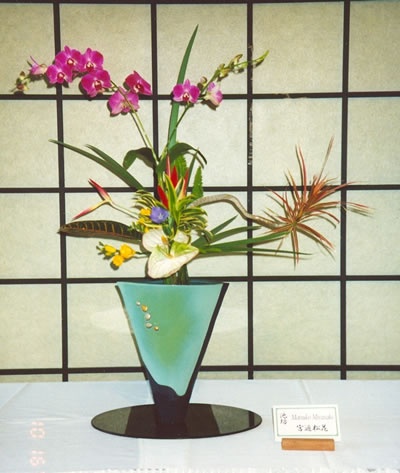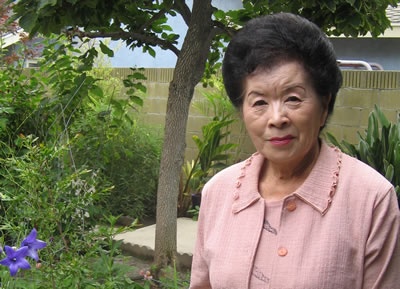Comforted and calmed by flowers: Relationships born through flowers
The history of Ikenobō is synonymous to the history of ikebana. Acclaimed as the “roots of ikebana,” Ikenobō has a longstanding tradition of over 500 years. The current iemoto (grand master), Sen’ei Ikenobō, represents the 45th generation. Ikenobō has evolved from simple arrangements of flowers in the tokono-ma (living room alcove) of Japanese houses, and now has three established styles called tachibana, ikebana, and jiyu-bana (free-form).
Youka Shiba, the current district vice-chair of the Los Angeles district Ikenobō, decided to take up flower arrangement with the influence of her foster mother, who was the head of an Ikenobō group called the Ayabana-kai. Shiba-san had been welcomed by her relatives as an adopted daughter after coming stateside from Japan.
"I had gotten married myself, and helped out at my American parents’ grocery store while raising my own children. During such a busy time in my life, my mother tried to teach me (Ikenobō) with an iron fist, but I have to say I wasn’t a very proactive student back then."
Looking back, Shiba-san says that she started to become heavily involved with ikebana around 1970, when her mother fell ill, and she herself was put in a position to lead the Ayabana-kai. In 1983, for the 30th anniversary of the group, she invited the iemoto from Japan and put together a grand celebration. "I feel so grateful that I had been able to do ikebana, especially when I feel comforted and calmed by the flowers themselves. I’m also grateful for all of the people I’ve met—the relationships that were born through working with flowers."
The most devout student of hers is said to be a 90 year old, who has continued since the days when Shiba-san’s mother was an instructor. After hours of teaching at a temple in Little Tokyo, Shiba-san shifts her location and heads to a condominium for seniors where many of her students live. She makes these outside visits twice a month nowadays. In addition, she also holds classes every week at her residence.
Taking care of the "life" of each and every flower: Energy can be felt from a single flower
"Is the 'heart of the flower' something that can be felt or understood universally?" We posed this question to Shiba-san, who has taught several Americans over the years.
"If one stays involved, stays devoted (to ikebana) for a long time, the heart of the flower will communicate with you, regardless of whether you’re Japanese or not. American flower arrangement is something completely different. Japanese ikebana, and especially Ikenobō, really takes care of the 'life' of each and every flower. Say, you pick a single flower from the yard, and put it in a small vase in the kitchen. Someone can look at it, and feel the spirit of the flower and become energized from it. When you have a bad day, looking at a flower can make you forget about it. Because the lifespan of a flower is short, it is full of vitality. It’s 'heart' is definitely felt by the students."
Beyond her anecdotes in America, Shiba-san revealed an even more international experience. This took place in New Delhi, India, where her daughter teaches at a school for the children of diplomats. "I did a demonstration at the elementary school my daughter teaches at. The children were already familiar with the term, 'IKEBANA.' My daughter had studied in the foreign division of Ikenobō while attending school in Kyōto, so she helped translate some ikebana jargon for me. I was deeply moved to find that ikebana had become this widespread over the world. I didn’t know at the time, but apparently there is an Indian division of Ikenobō as well."
Going out to the yard as a daily job: Growing the flowers with my own hands
Shiba-san struggled to find material (flowers, etc.) for ikebana in India, and the same problem was apparent in America as well. One cannot find all of the materials incorporated in a traditional ikebana style, like Ikenobō, in American flower markets. There is a necessity to make full use of your own yard and grow plants and flowers yourself. Over at Shiba-san’s Anaheim residence, there are a variety of seasonal flowers planted in her garden. "My daily job is to first water the plants, then pick out the wilted flowers and leaves. Wilted portions can take away energy from the other healthier plants around. So I always tell the wilted flowers, 'I’m sorry, but I have to...,' and pull them out."
The flowers grown here with much love and care end up in beautiful arrangements all over her home—on the dining table, on the living room shelf, in the kitchen, in the bathroom. Instead of looking like it has been 'arranged,' the flowers look as if they "naturally belong there, as flowers being flowers." Although she says she was half-forcefully brought into the world of ikebana by her mother, she says she is full of appreciation. Especially after the loss of her mother six years ago, the flowers were there to help ease her pain. She says the flowers have life, and keeping in touch with its spirit is the secret to keeping her youth. Indeed, watching Shiba-san energetically work with the flowers, it is hard to believe that she has a 20 year old grand-daughter.
Shiba-san has an ambition to continue contributing to the Nikkei community through ikebana. We hope she will spread the "heart of the flower" past the California borders and across the world—as far as India, perhaps.
Profile: Came to America in 1945 as a study abroad student. Joined the Ikenobō school through the insistence of her foster mother in America. Begins instructing in 1986, appointed to work as the vice-chair of Los Angeles district Ikenobō in 2001. Actively involved with community service for the Shizuoka Kenjin-kai, Southern California Women’s Association (Nanka Fujin-kai), and the Orange County Nikkei Association. Hobby: Karaoke. Currently resides in Anaheim.
© 2008 Keiko Fukuda








